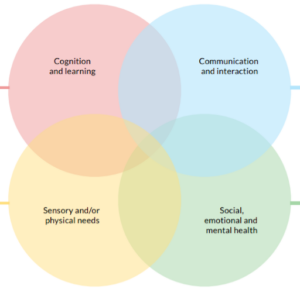SEN Teacher - Boosting Progress in Literacy and Numeracy
Every student with special educational needs possesses unique strengths and abilities. As an SEN teacher, supporting pupils to reach their learning goals in literacy and numeracy is challenging, rewarding and fulfilling.
There are currently just under 1.5 million students in England with special educational needs. In most cases, children with SEN will attend mainstream schools, and may face challenges due to dyslexia, autism, ADHD, or broad spectrum learning disabilities. Our focus in this post is on strategies for helping students reach their potential across the core subjects.

What areas of SEND are typically found in schools?
The four main areas, as identified by the SEN code of practise (2015) are:
- Cognition and Learning
- Sensory and/or Physical Needs
- Communication & Interaction
- Social, Emotional & Mental Health
These areas are by no means a full list of needs an individual may have, but provide a useful starting point. Additionally, it is likely that a student with SEND may experience difficulties in more than one of these four key areas. This means when considering support for a student, teachers should consider any ‘overlapping needs for pupils.’
For example, students with communication and interaction difficulties may also find cognitive functioning challenging. These considerations enable us as educators to build up a fuller picture of an individual’s needs. These discussions should take place involving the SENCo and other professionals that support the child.
 EEF Report: Special Educational Needs in Mainstream Schools
EEF Report: Special Educational Needs in Mainstream Schools
For further guidance, we recommend reading the Education Endowment Foundations (EEF) report ‘Special Educational Needs in Mainstream Schools.’ They claim that the attainment gap between students with SEND and their peers is double the gap between pupils eligible for free school meals and their peers. This highlights the fact that more needs to be done to bridge these gaps. Our suggestions below have been informed by the report’s 5 key recommendations, which are:
- Create a positive and supportive environment for all pupils without exception.
- Build an ongoing, holistic understanding of your pupils and their needs, using an ‘assess, plan, do, review’ approach.
- Ensure all pupils have access to high-quality teaching, or “good teaching for pupils with SEND is good teaching for all.”
- Complement high-quality teaching with carefully selected small-group and one-to-one interventions.
- Work effectively with Teaching Assistants.
Strategies for supporting students with SEN in core subjects
1) Adopt a Clear Strategy for Verbal and Written Instructions
Depending on the individual learning needs of students, some are quite capable once they understand what is required of them. This means that we must be really careful when delivering instructions. This can easily be the point where some students start to feel lost in lessons, particularly if we waffle on a little and haven’t thought through exactly how we’re going to deliver our instructions for the benefit of all students.
Verbal Instructions:
- Maintain a routine when giving verbal instructions. E.g. standing in the same place each time.
- Keep instructions clear and concise.
- Ask the student to repeat the instruction to a partner.
Written Instructions:
- Always include clear step-by-step instructions on the board.
2. Use Precise Praise to Encourage Students
By ‘precise’ we mean link praise to something specific that the student has done well (ideally a literacy or numeracy learning objective!)
- “You did a great job at sounding out that tricky word by using your letters and sounds!”
- “I’m so impressed at how hard you worked to sing that song without the words in front of you!”
- “You got your resources out ready for Maths without any prompting at all, fantastic work!”
3. Develop a repertoire of strategies that support high-quality teaching
Building on the assertion that good teaching for pupils with SEND is good teaching for ALL, the EEF have outlined the five strategies which are well-evidenced to have a positive impact on learning.
The EEF support the use of a ‘five-a-day’ principle in which teachers consciously include the below strategies in our lesson delivery every day:
- Explicit Instruction – Use of clear explanations, modelling and frequent check on understanding, followed by guided practice before independent practice.
- Cognitive & Metacognitive Strategies – Give students opportunities to plan, monitor and evaluate their learning. This helps to break down and manage the cognitive load giving new information a better chance of entering students’ long-term memory.
- Scaffolding – Provide supportive tools or resources such as sentence openers, vocabulary banks or partially written examples. The aim is for less scaffolding to be provided as you progress through the learning topic, leading towards greater independence.
- Flexible Grouping – Targeted temporary booster groups that are based on current level of confidence with a topic are seen to be highly effective. For example, a booster group during assembly that tackle a particularly tricky spelling pattern before the main class work on it together.
- Using Technology – Class visualisers, mini whiteboards and recording devices can be highly effective in enabling students’ to work with modelled examples, and to evaluate and improve their own learning.
How many of these strategies, or similar, do you use regularly in the classroom? Are there any that you could incorporate more often for the benefit of ALL learners?
4. SEN Teacher Numeracy Support for SEN Students
To support students who have difficulties with numeracy, we recommend the following best practices:
- Be practical – include examples and models of how resources can be used
- Be fun – include lots of games and activities that aim to make maths enjoyable or are linked to contexts that interest the students.
- Develop good mathematical vocabulary – plan for modelled conversations between the adult and child. Consider using speaking frames to ensure the correct use of mathematical vocabulary is practised regularly.
5. SEN Teacher tips for Literacy Support
Teaching Literacy brings with it a distinct set of challenges as the auditory, visual and motor skills of students are tested to the max.
- Consider Handwriting tools – would the student benefit from a pencil grip, writing slope, illuminated writing boards of cursive writing aids? There are a number of tools available which may help remove barriers to learning.
- Use of timers – Students with ADHD and other learning disabilities can find it incredibly difficult to keep track of time. Timers (which could be audible, light up or liquid – choose one which is easy on the senses and doesn’t cause additional stress) can be used to help children break their learning time down into more manageable chunks.
- Providing calm, quiet spaces – making sure that your learning environment includes a spot where children can go to sit and read quietly should they become overwhelmed.
Thank you for reading our post on supporting SEN students with core learning objectives.
Remember that when working with Prospero Teaching, you have access to our Training & Development Team (all qualified teachers with experience as interviewers) for any advice needed. Do you have an interview or trial day for teaching assistant jobs with us? The T&D team will always be in touch beforehand to go over a few details and answer any questions you may have.
Check out our current vacancies if you’re looking for primary or secondary SEN teaching assistant jobs or intervention teacher jobs. If you’d like to have a chat with a friendly consultant, then register your interest and we’ll soon be in touch!
Teaching Blog
No results found.....